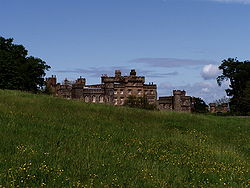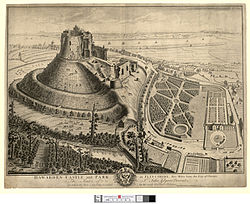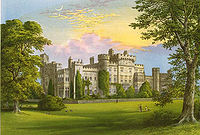Difference between revisions of "New Hawarden Castle"
(Created page with "{{Distinguish|Hawarden Old Castle}} {{Infobox house |name=Hawarden Castle |village=Hawarden |county=Flintshire |picture=New Hawarden Castle.JPG |picture caption=Hawarden Castl...") |
|||
| Line 7: | Line 7: | ||
|picture caption=Hawarden Castle | |picture caption=Hawarden Castle | ||
|os grid ref= | |os grid ref= | ||
| − | |latitude= | + | |latitude=53.182697 |
| − | | | + | |longitude=-3.017289 |
|type=Country house | |type=Country house | ||
|ownership=Lord Gladstone | |ownership=Lord Gladstone | ||
|website= | |website= | ||
}} | }} | ||
| − | '''Hawarden Castle''' or, to distinguish it from its predecessor, '''New Hawarden Castle''', is an eighteenth century country house with its estate which once belonged to William Ewart Gladstone, a long serving Victorian Prime Minister. It had previously belonged to the family of his wife, Catherine Glynne.<ref>{{cite book|url=http://www.gutenberg.org/etext/20012 |title=The Hawarden Visitors' Hand-Book|authorlink=William Henry Gladstone|year=|publisher=first=William Henry |last=Gladstone}}</ref> Built in the mid-18th century, it was later enlarged and externally remodelled in the Gothic taste. | + | '''Hawarden Castle''' or, to distinguish it from its predecessor, '''New Hawarden Castle''', is an eighteenth-century country house in [[Flintshire]], with its estate, which once belonged to William Ewart Gladstone, a long-serving Victorian Prime Minister. It had previously belonged to the family of his wife, Catherine Glynne.<ref>{{cite book|url=http://www.gutenberg.org/etext/20012 |title=The Hawarden Visitors' Hand-Book|authorlink=William Henry Gladstone|year=|publisher=first=William Henry |last=Gladstone}}</ref> Built in the mid-18th century, it was later enlarged and externally remodelled in the Gothic taste. |
==History== | ==History== | ||
[[File:Hawarden Castle and Park, in Flintshire, five miles from the city.jpeg|left|thumb|250px|Hawarden Castle and New Hawarden Castle, 1740]] | [[File:Hawarden Castle and Park, in Flintshire, five miles from the city.jpeg|left|thumb|250px|Hawarden Castle and New Hawarden Castle, 1740]] | ||
| − | The core of the present house is formed by a mansion built in 1752-7 for Sir John Glynne, 6th baronet, to the designs of Samuel Turner the elder of Whitchurch. It replaced the 16th century Broadlane Hall, the seat of the Ravenscroft family, which stood some way to the south. Glynne had acquired the estate through marriage. The new house was of brick with stone dressings. The main block was three storeys high, and seven bays wide, with a projecting three bay central pediment. Two flanking side pavilions were planned but may not have been completed.<ref name=cadw/> | + | The core of the present house is formed by a mansion built in 1752-7 for Sir John Glynne, 6th baronet, to the designs of Samuel Turner the elder of Whitchurch. It replaced the 16th-century Broadlane Hall, the seat of the Ravenscroft family, which stood some way to the south. Glynne had acquired the estate through marriage. The new house was of brick with stone dressings. The main block was three storeys high, and seven bays wide, with a projecting three-bay central pediment. Two flanking side pavilions were planned but may not have been completed.<ref name=cadw/> |
[[File:Hawarden Castle Morris edited.jpg|right|thumb|200px|Gladstone's Hawarden Castle circa 1880]] | [[File:Hawarden Castle Morris edited.jpg|right|thumb|200px|Gladstone's Hawarden Castle circa 1880]] | ||
| Line 28: | Line 28: | ||
In its grounds are the ruins of a mediæval castle, [[Hawarden Old Castle]]. | In its grounds are the ruins of a mediæval castle, [[Hawarden Old Castle]]. | ||
| − | The house is designated a Grade | + | The house is designated a Grade-I listed building.<ref name=cadw>{{jura|4|Hawarden Castle (New)}}</ref> |
==Outside links== | ==Outside links== | ||
| Line 35: | Line 35: | ||
==References== | ==References== | ||
{{reflist}} | {{reflist}} | ||
| − | |||
| − | |||
Latest revision as of 16:08, 14 January 2019
- Not to be confused with Hawarden Old Castle
| Hawarden Castle | |
| Flintshire | |
|---|---|
 Hawarden Castle | |
| Location | |
| Location: | 53°10’58"N, 3°1’2"W |
| Village: | Hawarden |
| History | |
| Country house | |
| Information | |
| Owned by: | Lord Gladstone |
Hawarden Castle or, to distinguish it from its predecessor, New Hawarden Castle, is an eighteenth-century country house in Flintshire, with its estate, which once belonged to William Ewart Gladstone, a long-serving Victorian Prime Minister. It had previously belonged to the family of his wife, Catherine Glynne.[1] Built in the mid-18th century, it was later enlarged and externally remodelled in the Gothic taste.
History
The core of the present house is formed by a mansion built in 1752-7 for Sir John Glynne, 6th baronet, to the designs of Samuel Turner the elder of Whitchurch. It replaced the 16th-century Broadlane Hall, the seat of the Ravenscroft family, which stood some way to the south. Glynne had acquired the estate through marriage. The new house was of brick with stone dressings. The main block was three storeys high, and seven bays wide, with a projecting three-bay central pediment. Two flanking side pavilions were planned but may not have been completed.[2]
In 1809-10 Sir Stephen Glynne, 9th Baronet, had the house enlarged, and the exterior completely remodelled in a crenellated Gothic Revival style, by the London architect Thomas Cundy the elder, although the Georgian interiors were preserved. In around 1830 the main entrance was moved from the south side to the north, and a vaulted porch added. There were further alterations to the house during Gladstone's occupancy, including a wing housing a library, designed by George Shaw of Saddleworth, built in the mid-1860s, a muniment room for the storage of his papers (1887-8), and an enlarged porch (1889), these last two both by Douglas and Fordham.[2]
In 1896 the then Archbishop of Canterbury, Edward Benson died at the castle and his body was put on the train at nearby Sandycroft station to be returned to London.[3]
Gladstone occupied the house until his death there in 1898, when it was inherited by his eldest son, William Henry Gladstone, who was High Sheriff of Flintshire for 1888. On the death of William Henry Gladstone it passed to his son William Glynne Charles Gladstone, who was killed in the First World War. The estate was subsequently purchased by his uncle Henry Gladstone, 1st Baron Gladstone of Hawarden. The house and estate are still a private residence (although some of the grounds are open to the public) and are still owned by the Gladstone family (the current proprietor is Sir William Gladstone).
In its grounds are the ruins of a mediæval castle, Hawarden Old Castle.
The house is designated a Grade-I listed building.[2]
Outside links
References
- ↑ Gladstone. The Hawarden Visitors' Hand-Book. first=William Henry. http://www.gutenberg.org/etext/20012.
- ↑ 2.0 2.1 2.2 Cadw listing (4) - Hawarden Castle (New)
- ↑ Flintshire CC - The Archbishop's death at Hawarden

